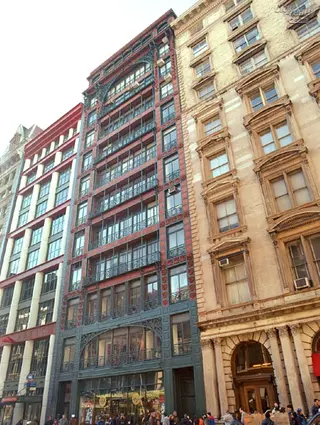 Carter Horsley
Carter HorsleyAug 31, 2012
Carter's Review
The 12-story building at 561 Broadway between Prince and Soho streets in SoHo is one of the city’s finest architectural masterpieces.
It was erected in 1903 and designed by Ernest Flagg, who would five years later completed the 47-story Singer Tower office tower at 149 Broadway at Liberty Street in the Financial District that was the world’s tallest building when it was completed. It was demolished in 1967 to make way for the U.S. Steel Building.
The 12-story building would then become known as the “Little Singer” building.
Built to house the corporate offices and factory space for the Singer Manufacturing Company, it was converted in 1979 to a cooperative with a mix of residential and commercial uses with 20 offices and 15 live/work units for artists. It now has 22 cooperative apartments.
Bottom Line
An architectural masterpiece that combines considerable decorative ornamentation with broad glass expanses, this is one of the premier and most colorful buildings in SoHo.
Description
It is an L-shaped building that has a narrower but quite similar midblock façade at 88 Prince Street.
Although the building’s façades are highly decorative with wrought-iron tracery and clay-colored terra-cotta ornamentation, the building is widely considered an important forerunner of glass-curtain-wall skyscrapers that were popular in the later decades of the 20th Century.
Suspended from a structural frame, this highly ornamented façade is the forerunner of the glass curtain walls found in post-World War II skyscrapers.
Tom Miller’s website, “Daytonian in Manhattan,” has noted that “the architect’s creation is at once whimsical and elegant,” adding that “by recessing the windows, he allowed for row after row of lacy cast iron balconies which at a glance appear to be identical yet each has subtle differences.”
“The ornate cornice is supported by decorative, scrolled iron brackets, reminiscent of those found on Flagg’s earlier Mill’s House on Bleecker Street,” Mr. Miller continued. The brackets are thin and quite large and support a cornice beneath the top floor and above a large arched grill over a recessed row of windows.
In 2008, the rebuilding was extensive renovated by Bone/Levine Architects, a tenant in the building, and a slanted glass-and-ironwork sidewalk canopy was recreated from old photographs.
The building would have been demolished to make way for the Lower Manhattan Expressway, one of the more controversial plans by Robert Moses.
The site was formerly occupied by Henry Wood’s Marble Hall, a 2,000-sear theater that was famous for showing Christy’s Minstrels.
Amenities
The mixed-use building has a doorman.
It has no garage and no roof deck.
Apartments
Apartment 9CD has a 28-foot-long bedroom and a 51-foot-long living room with an open kitchen.
A two-bedroom unit has a 42-foot-wide living area with an open kitchen with an island and a 18-foot-long alcove.
Another two-bedroom unit has a 25-foot-long living room with a 23-foot-wide open kitchen with an island.
Apartment 5A has a 32-foot-long living/dining room facing broadway with a 20-foot-long alcove and an open 12-foot-long kitchen and two enclosed sleeping areas.
History
In their great 1983 book, “New York 1900, Metropolitan Architecture and Urbanism 1890-1915,” authors Robert A. M. Stern, Gregory Gilmartin and John Massengale, wrote that “Drawing upon the arguments of the French Rationalist architect Viollet-le-Duc and some of his proposed designs which used exposed iron and masonry in combination, Flagg set out to express the structure as directly as possible.”
“Although he was forced to cover the steel frame with fireproofing,” they continued, “he abandoned his usual representation of the Classical orders and set the glass back form the face, sheathing the exterior with a metal lattice made up of decorative iron, terra cotta and glass and carrying Viollet-le-Duc’s principles to a logical extreme. The intricate façade seemed as beguilingly transparent as a lace curtain, yet as solid as a thick masonry wall.”
In his fine book, “Lost New York,” expanded and updated in 2000, Nathan Silver noted that Flagg’s “impressive design of the little Singer building…, which survives, led to his commission of the forty-seven-story Singer Tower….the tallest building in the world from 1908 until the completion of the Metropolitan Life Tower eighteen months later. The tower’s projecting attic floors, mansarded roof and lantern long remained a characteristic figure I the new York skyscape….The shaft rose above the lower section – a building stage that been completed earlier – with an unprecedented slenderness…,braced by crossed diagonals in the corners, a kind of support against wind pressure now commonly used in steel buildings. The demonstration of a tall tower limited to a quarter of the site included New York’s 1916 zoning ordinance. The form of Flagg’s tower top, and the materials of his extroverted lobby of colored marble, bronze and glass saucer domes…,reflected some of the stylistic preoccupations of his training at the Ecole des Beaux-Arts in Paris. But the main exogenous inspiration seems to have been the client’s product: that ornamental, practical, technologically advanced turn-of-the-century Singer sewing machine, whose logo even appeared on the lobby capitals.”

- Co-op built in 1903
- Converted in 1979
- 1 apartment currently for sale ($5.25M)
- Located in SoHo
- 22 total apartments 22 total apartments
- 10 recent sales ($1.6M to $8.9M)
- Doorman
 6sqft delivers the latest on real estate, architecture, and design, straight from New York City.
6sqft delivers the latest on real estate, architecture, and design, straight from New York City.
